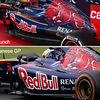Technical analysis: Toro Rosso STR10
Following a number of 'launches' with online pictures, Toro Rosso were the first team to show their true car to the world, and it turned out to be an interesting piece of machinery.
The team has recently had a history of creating unique cars, resulting from out of the box thinking of its engineering team. That team, lead by renowned F1 designer James Key interestingly has two Chief Designers. Paolo Marabini is in charge of composites and structures while Matteo Piraccini leads the mechanical and systems designs.
The result is once again a car different to any of the others seen for 2015.
At the front, Toro Rosso follows Ferrari's and McLaren's design ideas by creating a long nose, extending ahead of the front wing. Different however to the MP4-30 and the SF15-T, the Toro Rosso does feature a sloping upper profile of the monocoque, seemingly identical to the shape of the monocoque of the STR9. On the upper side this makes for a smoother slope from tip to cockpit opening.

Retaining a nearly identical monocoque has also enabled the team to more or less keep the layout of the front suspension. This still features nearly horizontal wishbones and is a push rod design. The main difference here is the alignment of the steering arm with the frontal upper wishbone for aerodynamic purposes.

Looking at the car behind the driver, it is immediately clear that the Italian team has managed to dramatically reduce the size of the sidepod apertures, as well as the outer dimensions of the sidepods themselves. No other team has yet come up with such an aggressive sidepod shape which is clearly aimed at optimising airflow around the pods. The less bulky pods will allow a much better flow low onto the rear diffuser.
However, there isn't really a magic bullet in Formula One - if you don't consider Adrian Newey - so compromises had to be made in order to house all components and make sure the Renault combustion engine and its ERS systems do not overheat.
To make up for the missing space in the sidepods, Toro Rosso have considerably enlarged the airbox area, making for a very large, oval air intake above, and partly behind the driver's helmet. Note that this intake is essentially split in two, feeding both the turbo and providing cooling air to some components. And since that didn't seem to be enough, the launched car also features ears as Mercedes' F1 W05 did in 2014, catching that extra bit of air.
As long as the uncovered car is not seen, it's not entirely clear where all components sit, but it is evident that Toro Rosso have chosen to have more items close to the car's centre line, above or behind the power unit.
While having all these components sit higher up in the car, one would image that the team opted to go for a funnel hot air exit around the exhaust. But again, Toro Rosso opted otherwise. Instead, the team has designed wide hot air exits on each side of the gearbox while leaving just a few centimetres of opening around the exhaust pipe.

The rear suspension retains a similar layout as on the STR9. The system continues to be activated with a pull rod while the track rod and drive shaft are still aligned for aerodynamic purposes. The obvious difference compared to the STR9 however is that the frontal wishbone and pull rod now protrude the bodywork as this extends further to the back.
Finally, the rear wing. This continues to be supported in the middle by a pillar that mounts on a carbon fibre bridge over the exhaust pipe. It's less obvious on the launch-spec STR10, as the bodywork is made to exactly fit the dimensions of the bridge. Attached to the central mount is a new, double-element monkey seat. The rear wing itself though looks very similar, if not identical to the once run in last year's Abu Dhabi test, suggesting there may well be a new version coming up shortly.







